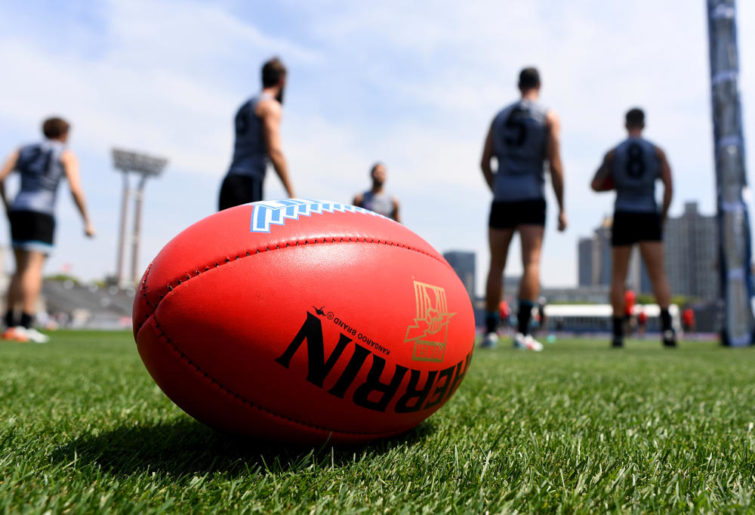Michael Georgiou
new author
Roar Rookie
Opinion
When they reach the AFL, footy players are seen as superheroes – but it’s a long road to get to the top.
It takes a lot of work to become an AFL star, and some people aren’t cut out for the long haul. For the players who make it, the end result is a life and career where they never stop learning. So what does it take to become an elite footballer?
Stefan Valensisi, who plays for the Northern Saints – the local football club of Fawkner and part of the Essendon District Football League’s (EDFL) division two – describes how his club readies players like him for the next stage.
“They help develop our ability to play in multiple positions on the ground that so that we are versatile as footballers and can be used for a variety of roles,” he tells Draft Watch.
“They also help develop our leadership abilities so that we can stand out as not only players, but as leaders.”
This versatility is something they will come across later in professional football, so preparing from a young age is important.
Once a player is picked up by a NAB League team, this is where their preparation for the big leagues accelerates.
The competition is one of the primary sources of player recruitment for AFL clubs in Victoria and provides an opportunity for players to compete in high standard competition in preparation for AFL.
Rhy Gieschen, talent manager for NAB League team Northern Knights, said there are many elements that go into preparing players for the AFL.
“There’s the football element, so training and skill development. And then there is the physical aspect, so strength conditioning,” he said.
“There’s also a mental aspect, assisting their well being and balance. All of this goes into preparing them for a possible future career in the AFL.”
While the NAB League is its own competition, teams must focus on developing players for the future and not just for their own team’s success, as suggested by Damian Carroll, assistant coach for Hawthorn FC and former coach of NAB League team Gippsland Power.
“I believe that when developing young players, we need to look at effective coaching rather than basing our success on results coaching,” he told AFLcommunity.com.au.
“This means that we need to have a mentality of coaching young players for the future rather than just coaching for the present.”

(AAP Image/Tracey Nearmy)
This is how players are prepped for actually playing the sport, but they also have to be primed and set for the AFL Draft.
The draft doesn’t always go the way some players would hope, in terms of their placement and what team drafts them, or whether they are drafted at all.
Gieschen says players need to keep their expectations realistic and that the club supports them.
“We provide feedback on a weekly basis for the top under-15s to 18s to ensure they obviously have the right mindset and expectations to know where they sit on the draft board or pecking order and what the AFL clubs are saying about them throughout their time,” he said.
Mental health in sport has become a bigger issue in recent years, especially in AFL. There has been a number of players revealing they suffer from mental-health issues, taking time off as a result.
Support is being shown from the AFL all the way down to the local clubs. Valensisi says his club warns the players about the dangers of mental health and that they are there to support them if needed.
“The footy club is considered one big family where you can be confident to open up about any issues and knowing you’ll get the trust and respect from your teammates to support you,” he said.
“As well as that, they have educated us about making sure we speak to someone about our issues instead of holding them in and letting things get worse.”
In the NAB League teams, players are older, therefore mental health is a much bigger issue. These clubs must support their players and that is exactly what they do.
“We have a psychologist for support in the boy’s program as well as a wellbeing coordinator in both the boys’ and girls’ programs that work closely with individuals within the programs both proactive and reactive to any issue that may arise,” Gieschen said.
There is a lot of work that goes into preparing kids to become AFL players, so much work that it continues into their AFL career.
Manny Lynch, former Brisbane Lions head of welfare, leadership and culture, said in an article for Lions.com.au in 2013 that the club runs a camp for first- and second-year players. This camp is run to help young players with their transition into AFL.
“It’s expected that first-year boys will deal with insecurities, uncertainty, homesickness and anxiety at times,” Lynch said.
The second-year players are there to support the first years, because they were in their shoes the year before, and could possibly still be transitioning themselves.
“So the players come out of [the camp] feeling a stronger sense of belonging, and know they have a lot of support,” he said.
An AFL player is idolised by millions of people, but what they forget is that this player was once a kid with a dream.
A dream that takes much work, preparation and education to achieve.